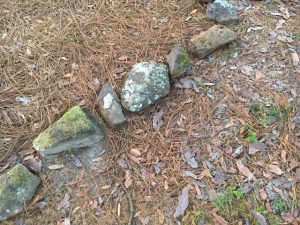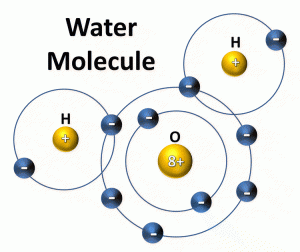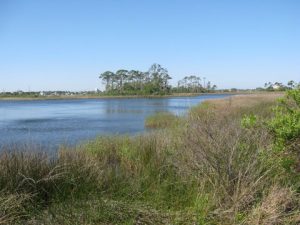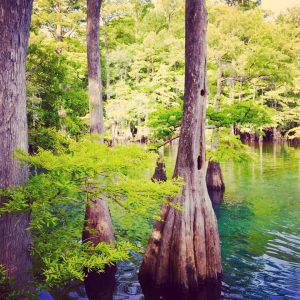In Lesson 1 we looked at the polarity of the magic molecule. The fact that water is has a positive and negative end and attaches to other molecules like a magnet. Because of this it is called the universal solvent and will, eventually, dissolve everything. This is the purpose of one of our homework assignments.

HOMEWORK ASSIGNMENT UPDATE
Some of you are participating in a homework assignment. You have placed an inorganic substance (like sand, or a rock) in one glass of water. In a second you have placed an organic one (like a leaf or a seed). And in a third you have placed a man-made object (like a nail, or a coin).
– It has been three weeks now, has anything changed in either of them? Are they dissolving yet?
Let’s discuss glass #1 – the inorganic.
In Lesson #3 I explained how the polar molecule water could (would) eventually dissolve the compound we call salt (NaCl into Na+ and Cl–). You can observe the salt actually dissolve in the water pretty quickly. In your case you may have placed a rock, or some sand, or dirt. This may not have dissolved yet – but it eventually will. Rock is made of minerals. Minerals are made of compounds (sand is a mineral). Compounds are electrically bonded. Water separates (dissolves) electrically bonded compounds because it is polar.

Image: Florida Atlantic University
As these inorganic compounds dissolve, they release their elements into the water. There are 92 natural elements found on planet Earth. Many of these are found in rocks and minerals and as water flows over them during the water cycle (Lesson #2) and erosion (Lesson #3) these elements are released into the water due to waters polarity (Lesson #1).
So, as water moves from the mountains to the sea the amount of elements dissolved in water increases. The amount of dissolved elements in the water is called salinity. We usually call salinity the amount of “salt” in water because we often refer to the elements of sand, rocks, and minerals as “salts” – and they are.

Photo: Physics.org
There is actually more than one kind of salt. We know of salt as NaCl, but it is actually the product of an acid and a base.
For example: hydrochloric acid (HCl; H+Cl–) combined with sodium hydroxide (NaOH; Na+OH–) recombine the positive and negatives to (HOH; H+OH–) and (NaCl; Na+Cl–) – HOH is H2O.
So, sulfuric acid (H2SO4 + NaOH à NaSO4 + H2O). NaSO4 (sodium sulfate) is a “salt”.
All of these inorganic “salts” (usually found in rocks and mineral) will dissolve into their elements as water in a river flows over them. As the river gets closer to the sea, the amount of dissolved elements (“salts”) increases. Another way of saying this, is the salinity increases as we get closer to the sea.
Salinity
Salinity is measured in parts per thousand. The average salinity of the ocean is 35. This is 35 parts per thousand. Meaning in seawater, for every 1000 parts of water, there is 35 parts of “salt”.
We are familiar with percent. This is parts per hundred. For example, if you got 87 out of 100 questions correct, you got 87% correct… you got an 87 on the test.
But parts per thousand would be two zeros. So, for parts per hundred we use %, but for parts per thousand we use ‰. Thus, the salinity of the ocean is 35‰.

If you checked the salinity in the lower part of the bay (Big Lagoon or Santa Rosa Sound) you would typically find something between 20-30‰. In the upper part of the bay (Escambia Bay, Blackwater Bay) you would find salinities between 10-20‰. In the bayous it could be between 10-20‰, or between 0-10‰. Any water that has a salinity between 0-30‰ is not called seawater but rather it is called brackish water. These bodies of water we call estuaries (where rivers meet the sea).
Interestingly, if you measure the salinity of a local river you will read 0‰ – freshwater. However, if you understand what we have gone over so far, you understand there ARE dissolved elements in this water – it is just that the amount is so low that the instrument cannot detect it. It smells like freshwater, and it taste like freshwater, but there are very small amounts of “salts” in it. The only true/pure H2O would be distilled water we have made.

As discussed in Lesson #3, flowing water changes the landscape which changes the type of life that lives in and near there. Salinity works the same way. Some plants and animals can not live in “salty water”. Others can. Some can only live in “seawater”, like sharks, sea turtles, and sea horses. Others only “brackish water”; like croakers, scallops, and diamondback terrapins. Some only in “freshwater”; like bass, bream, and crawfish. And then there are others who really do not care – they can live in any of them, like mullet, manatees, and gars. The salinity of the water creates different “habitats” for different creatures to live.
So, why is this?
Why does a snapper die in freshwater and a bass die in seawater?
It has to do with osmosis.
Osmosis is the process where material (like water) moves through a membrane with tiny holes in it (permeable membrane). It always flows from high amounts on one side of the membrane to the low side.

Image: Study Blue. University of Central Florida.
Your skin, and the skin of all creatures, is permeable. In this case the tiny holes in our skin are so tiny that only the water molecule can move back and forth – “salt” is too big, and so does not pass.
Here is an important part of this…
The fluid inside your cells (cytoplasm) is slightly “salty”. It has some dissolved elements in it.
Let’s say freshwater is 100% water – 0% “salts” (we already know that is not exactly true but for this example…) And your cells (or the cell of any plant or animal) is 95% water and 5% “salt”. And the plant/animal is in the freshwater water. The two (100:0 and 95:5) are not the same. But nature wants them the same, we will need to equalize these (make them equal). We just said that the tiny holes (pores) are too small for the salt to pass through, so only water can. So, water will move from HIGH amount (100) towards the LOW amount (95) and water will move INTO the plant/animal cell until they are equal. Water will pass from the lake into the plant/animal cell and it will expand.
Now, let’s place the plant/animal (95:5) into seawater, which is let’s say for this example… (90:10). Which way do you think the water will move now? What will happen to the water inside the plant/animal cell? What will happen to the plant/animal?
There is much more to discuss on the topic of salinity and life on our planet – but this is good for today. LET’S EXPERIMENT WITH THIS. Looks like a rainy day in Pensacola and a good day to do an inside experiment.
ACTIVITY
– We need plant cells for this. If you have them, grapes work really well.
– Make a glass of freshwater and add one grape to it.
– Make a glass of “seawater” and add another grape. If you live near saltwater, and it is not raining, and the beach is not closed, grab a sample of “saltwater”. If not, add some salt to water and mix it up good. We now understand this is not REAL seawater (would not work for your aquarium) but will work for this experiment.
– Let these sit over the course of a day or two. Which way do you think the water will move now? What will happen to the water inside the plant/animal cell? What will happen to the plant/animal?
– Next time you are in the grocery store, go to the salt aisle, find table salt and look at what “salts” are in it. You should find sodium chloride (NaCl). Now look at “Sea Salt” (which many stores sell. Which “salts” are in this product?
Again, looks like a rainy day today. Not much to do outside.
STAY SAFE AND HAVE FUN.
 0
0
